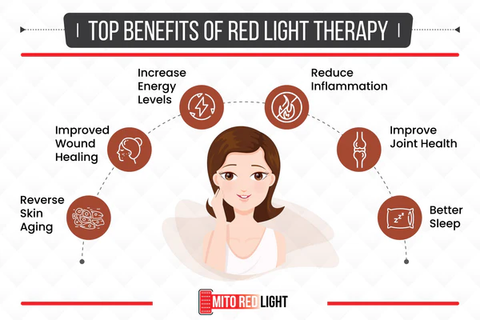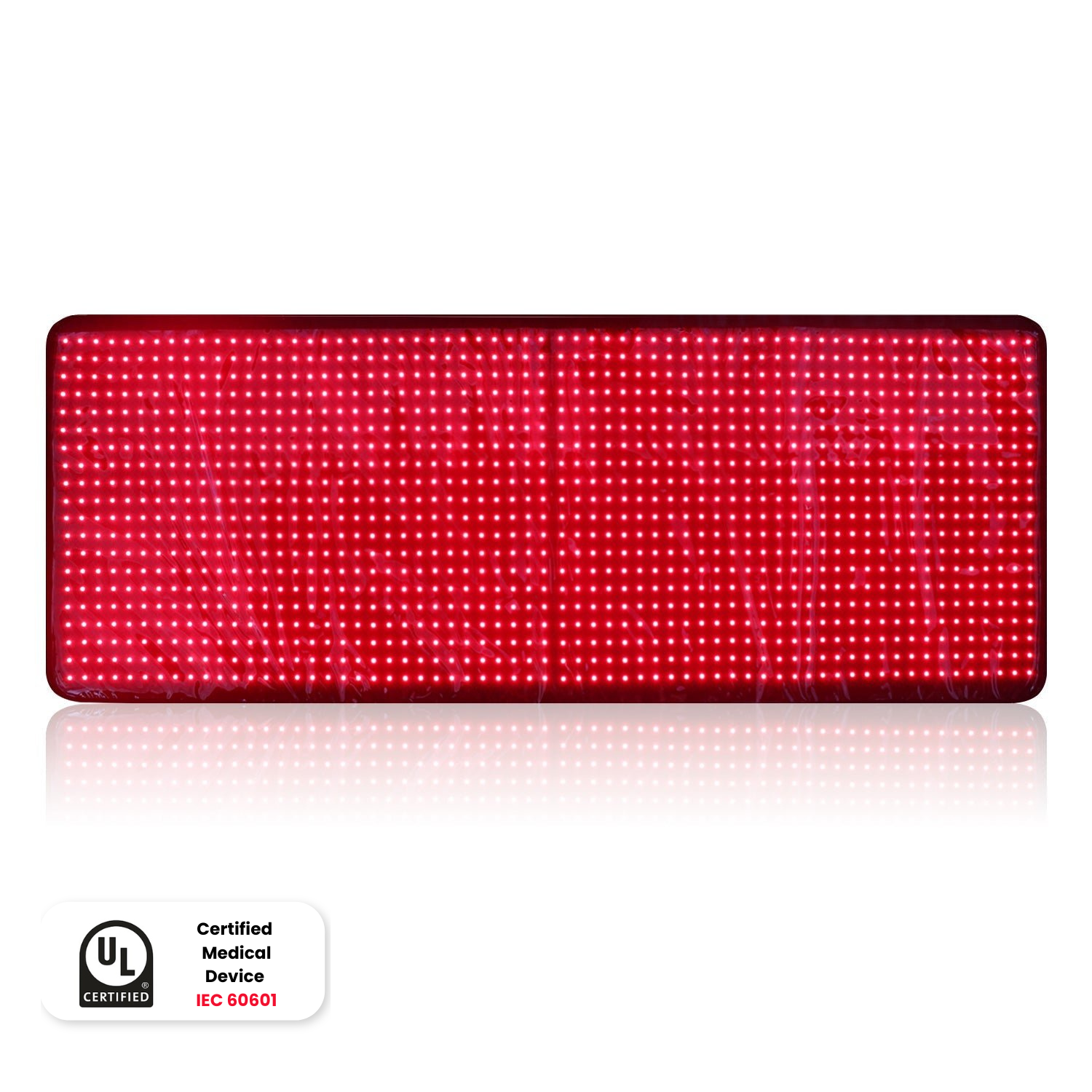DISCLAIMER: Mito Red Light devices are Class II wellness devices aimed at affecting the body through topical heating and supporting cellular function. The information provided in this article and on this site is for educational purposes only and is not intended to imply effectiveness of Mito Red Light devices for any specific application. The information provided in this article and on this site is not intended to diagnose, treat, cure, or prevent any disease, is not a substitute for consultation with a licensed medical provider and should not be construed as medical advice. Click here to read our article on potential contraindications of red light therapy..
Table of Contents
- What is Red and Near Infrared Light?
- How Does Red Light Therapy Work?
- Red Light Improves Cellular Energy Production
- Red Light Therapy Reaches Deep Tissues
- Red Light Therapy Safety
- Where Does Red Light Therapy Come From?
- Why Use Red Light Therapy?
- Decreased Exposure to Natural Light
- Mito Red Light
What is Red Light Therapy? Red and near infrared (NIR) light therapy, often simply referred to as “red light therapy”, is a type of therapy that uses specific wavelengths of light to bring about positive health benefits. This form of phototherapy uses wavelengths of light that are considered bioactive in humans.
People use red light therapy to improve skin quality, speed wound healing, stimulate hair growth, reduce chronic pain, and improve workout recovery times. Studies indicate that red light therapy’s effects occur due to the stimulative effect that red and NIR wavelengths of light have on mitochondria, the energy center of the cells.
What is Red and Near Infrared Light?
Red and near-infrared light are part of the electromagnetic spectrum and, more specifically, part of the spectrum of light emitted by the sun. These wavelengths of light are “bioactive” in humans.
The electromagnetic spectrum contains electromagnetic energy of many different wavelengths. The wavelength of this energy determines the properties it will have.
Below is a chart outlining the electromagnetic spectrum:

Electromagnetic waves vary greatly in wavelength, ranging from 0.0001 nanometers (gamma waves) all the way to over meters (radio waves). The shorter the wavelength, the greater the energy that a specific electromagnetic wavelength will contain.
As many people will have learned in high school physics, when someone passes white light through a prism, it separates out the different colors based on their wavelengths. Only a tiny part of this spectrum (roughly 400nm to 700nm) is actually visible to the human eye.

The longest wavelength within the visible spectrum is red light, which goes from a little over 600nm to approximately 700nm. Longer wavelengths just outside the visible light spectrum are considered near-infrared (NIR). This part of the spectrum ranges from about 700nm to a little over 1,100nm.
How Does Red Light Therapy Work?
So how does red light therapy work and what are some potential red light therapy benefits? The idea that simply shining light on your body can improve your health may sound too good to be true, but there is a large body of research shows that red light therapy help and explains how it actually functions.

Red Light Improves Cellular Energy Production
The best-studied mechanism of action surrounding red and near-infrared light therapy is the stimulation of mitochondrial energy production in the cells. Mitochondria are tiny organelles (organs within a cell) that produce all of the energy that our cells and our bodies ultimately need. Red light therapy is thought to primarily cause its positive effects by helping the mitochondria create more energy.
All molecules and atoms absorb very specific wavelengths of light. The specific molecule within the mitochondria that is thought to absorb red and near-infrared light is a chemical called cytochrome C oxidase. Cytochrome C oxidase plays an absolutely essential role in transferring electrons down an electrochemical gradient in mitochondria called the electron transport chain.

The electron transport chain is what drives the synthesis of ATP (adenosine triphosphate). ATP is a complex organic molecule that is considered the “currency” of energy in the body. While biological energy is derived from sugar, the energy in sugar would damage cells if it was all used at once. Mitochondria use a chemical reaction called the Krebs cycle to generate charged molecules. These charged molecules then pass through the electron transport chain, ultimately resulting in the synthesis of ATP.
Red light therapy is ultimately thought to improve the efficiency and speed of the electron transport chain, improving the availability of ATP in the cells and throughout the body. This increased energy is what is thought to provide the many benefits that red light therapy is used for.
Red Light Therapy Reaches Deep Tissues

One of the reasons that red light therapy specifically offers unique benefits when compared to other wavelengths of light is that it can penetrate much deeper than shorter wavelengths of light. Higher energy light is absorbed more quickly and only enters the more superficial layers of body tissues.
Short wavelengths of light, such as ultraviolet light, contain more energy than red or near-infrared light. These wavelengths, however, only reach the skin and do not penetrate deeply into the body.
Red light and near-infrared light, conversely, have longer wavelengths and are able to reach much deeper, penetrating through many layers of body tissue. This has two main effects:
- It reaches a greater amount of body tissue. While the light passes through many layers of body tissue, it has the potential to interact with every cell it touches, allowing for a larger volume of tissue to be impacted.
-
It reaches deep body tissue. Because it penetrates deeply, red and near-infrared light can reach areas of the body that are considered relatively inaccessible. Tissues like muscles, joints, and even brain tissues may be reached by these types of light.

It is important to keep in mind that while some wavelengths of light, such as green light, may reach a more medium depth, it is only red and near-infrared wavelengths that are considered to actually stimulate mitochondria. It is the effect of red light on mitochondria combined with its deep penetration that makes it such a valuable resource in phototherapy treatments.
It is specifically these red and near-infrared wavelengths that have amazing effects on our bodies. Most research showing the benefits of red light and near-infrared light have used wavelengths in the ranges of 620-680nm and 800-880nm.
There have been thousands of studies done in both animals and humans, examining the effects that it has on many different biological processes. Overall, red and near-infrared light has been repeatedly shown to have positive effects on cell function in animal and human studies and aid in improving a wide range of conditions.
Red Light Therapy Safety
Red light therapy is widely considered one of the safest forms of phototherapy. This is because red light and near-infrared light are low-energy forms of electromagnetic radiation. Short-wavelength light, like ultraviolet light, is considered high-energy light and carries known health risks, such as skin cancer and eye damage with retinal exposure.
Red light does not carry any known safety risks. While red light therapy providers recommend wearing protective glasses during red light therapy out of an overabundance of caution, there is not even conclusive evidence that red light therapy causes eye damage. In fact, some evidence suggests there may be eye-related benefits to using red light therapy.
While red light therapy is considered to be very safe, there are some circumstances where it is not recommended. These situations, however, are not due to known dangers that exist but to the fact that the safety has not been fully researched or proven. Red light therapy use on the abdomen during pregnancy, for example, is not known to cause any risks; however, it has not been conclusively proven to be safe and is not something that most researchers test in case there is some unknown negative effect.
Where Does Red Light Therapy Come From?
While the history of red light therapy would take a complete article to cover, the idea of phototherapy emerged in the late 1800s, with Dr. Niels Ryberg Finsen being awarded the 1903 Nobel Prize in Physiology or Medicine for his research in this area.
The benefits of light therapy using red and near-infrared light specifically were discovered as an incidental finding of NASA research in the mid-1990s. Researchers examining red light’s impact on plant growth found that skin blemishes healed quickly while they were frequently exposed to red light, a finding that quickly led to a whole new body of research and resulted in the use of red light therapy in humans.
Why Use Red Light Therapy?
There are many potential reasons that people use red light therapy. As this form of phototherapy continues to be researched, new potential benefits of red light therapy are still being discovered.
We dive deeper into each potential benefit of red light therapy in other articles, but some red light therapy benefits may include:
- Stimulates wound healing and tissue repair
- Reduces aging effects by supporting collagen production
- Reduces pain by decreasing swelling and inflammation
- Improves joint health
- Improves physical performance through improved muscle recovery and energy levels
- Improves sleep quality and duration
The myriad of potential benefits that red light therapy offers makes regular use of this form of phototherapy a mainstay of many people’s daily health routines.

Decreased Exposure to Natural Light
The human body requires light to function, with light playing an important role in processes such as making vitamin D, causing our mood to be upbeat, and regulating our body’s daily circadian rhythm. It is no surprise that the red and near-infrared light found in sunlight has biological effects on our bodies as well.

While light plays many important roles in health, modern humans are spending less and less time exposed to sunlight. Our housing, transport, and workspaces are often indoors, reducing our exposure to the beneficial health effects of natural sunlight. Furthermore, modern LED and CFL lighting is lacking in the beneficial wavelengths of red and near infrared light and energy-efficient windows in buildings and vehicles further limit our exposure to these wavelengths of light.

Mito Red Light
Changing your living situation, job, or transportation methods to be outdoors frequently is not practical for many people. This is why Mito Red Light exists, to help you get exposure to the beneficial wavelengths of red and near infrared light without having to significantly alter your lifestyle. Our high-quality red light therapy panels allow you to access the health benefits of red light from the comfort of your home or office and on your own schedule.
However, not all red light therapy devices are created equal. For red light therapy to be worth the investment, you need a high-quality, independently tested, professional red light therapy device from a reputable company. With over 5 years in business and over 65,000 ecstatic customers, Mito Red Light is a brand you can trust. Our nearly 2,000 reviews speak for themselves. You can also click to review some of our customers' red light therapy before and after examples.
We are confident that our devices are the highest quality and best value at home red light therapy devices available anywhere. We welcome you to review our selection of red light therapy devices or to contact one of our representatives at 1-866-861-6486 to learn more or to help find the right solution for you.
Related Articles:
- Everything You Need to Know About Red Light Therapy and INFLAMMATION
- Everything You Need to Know About Red Light Therapy and MUSCLE RECOVERY
- Everything You Need to Know About Red Light Therapy and SKIN






























